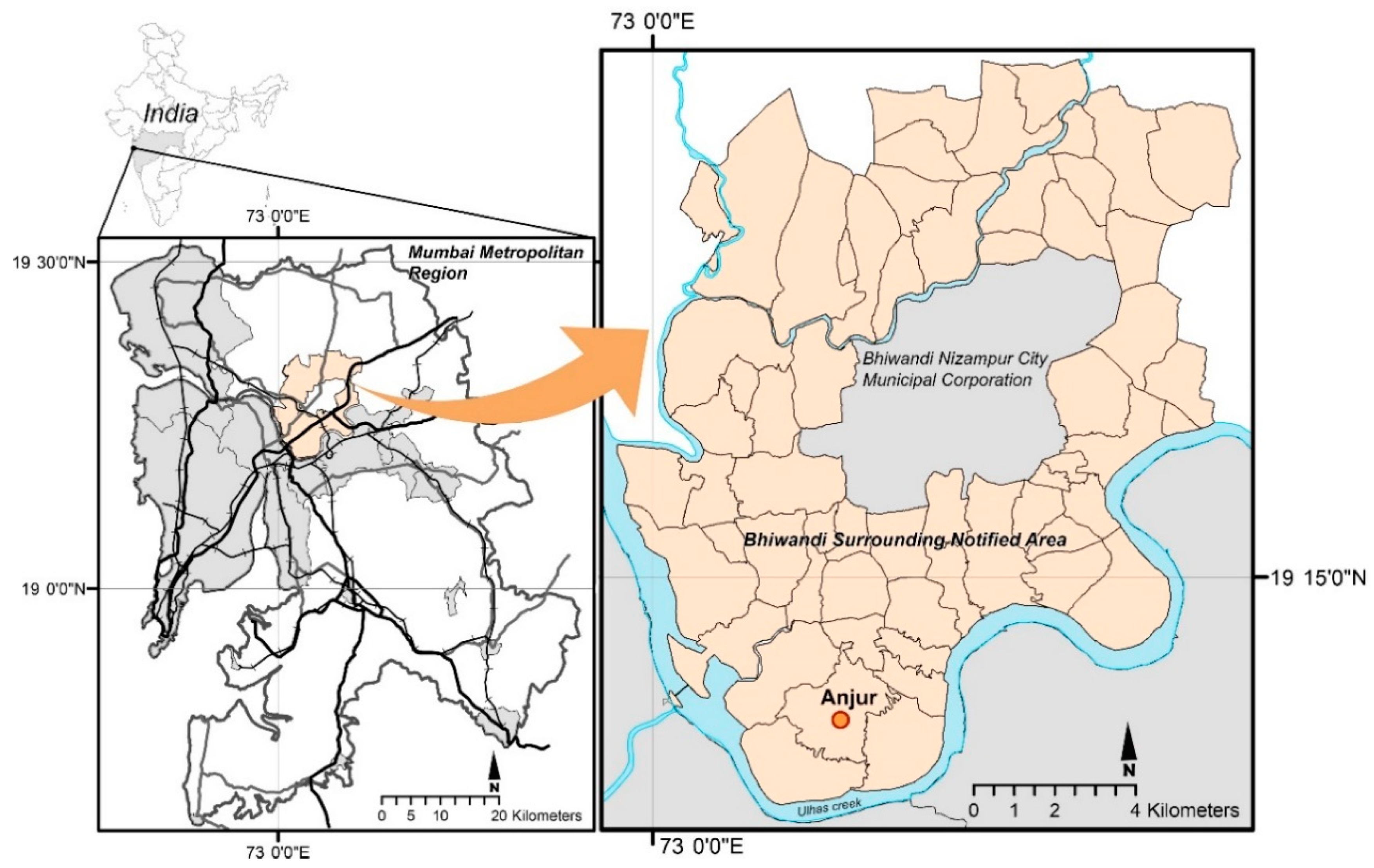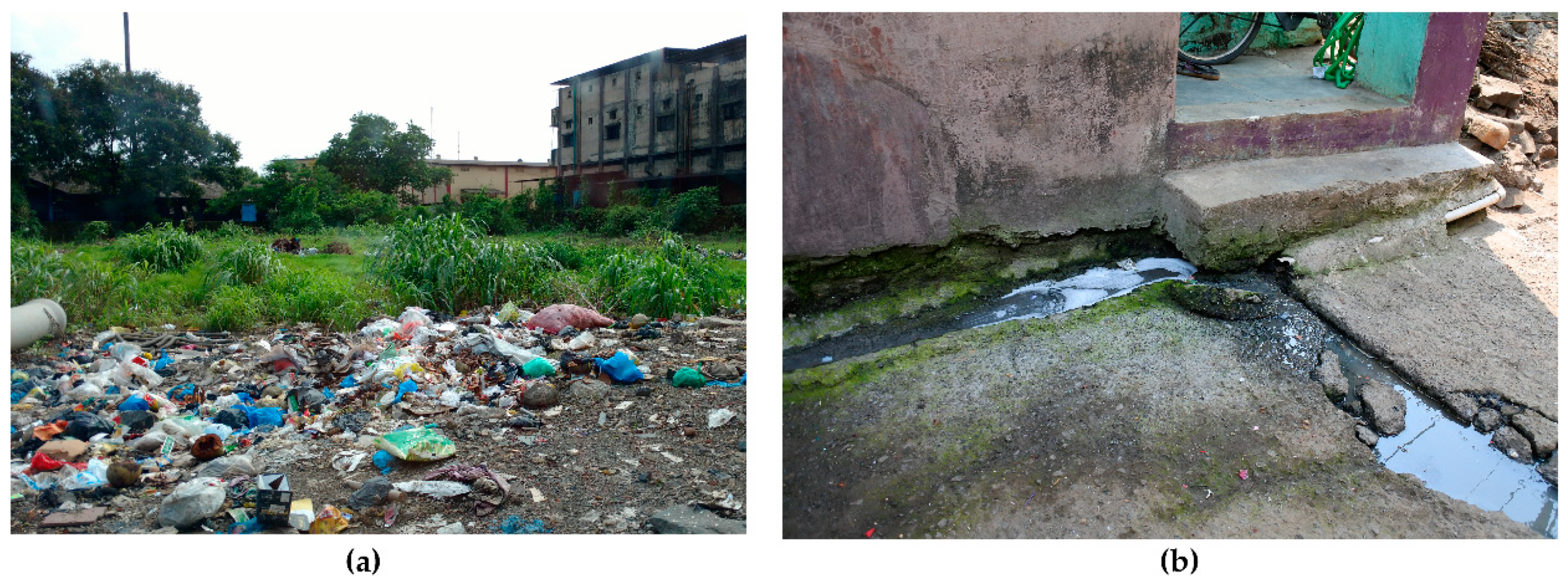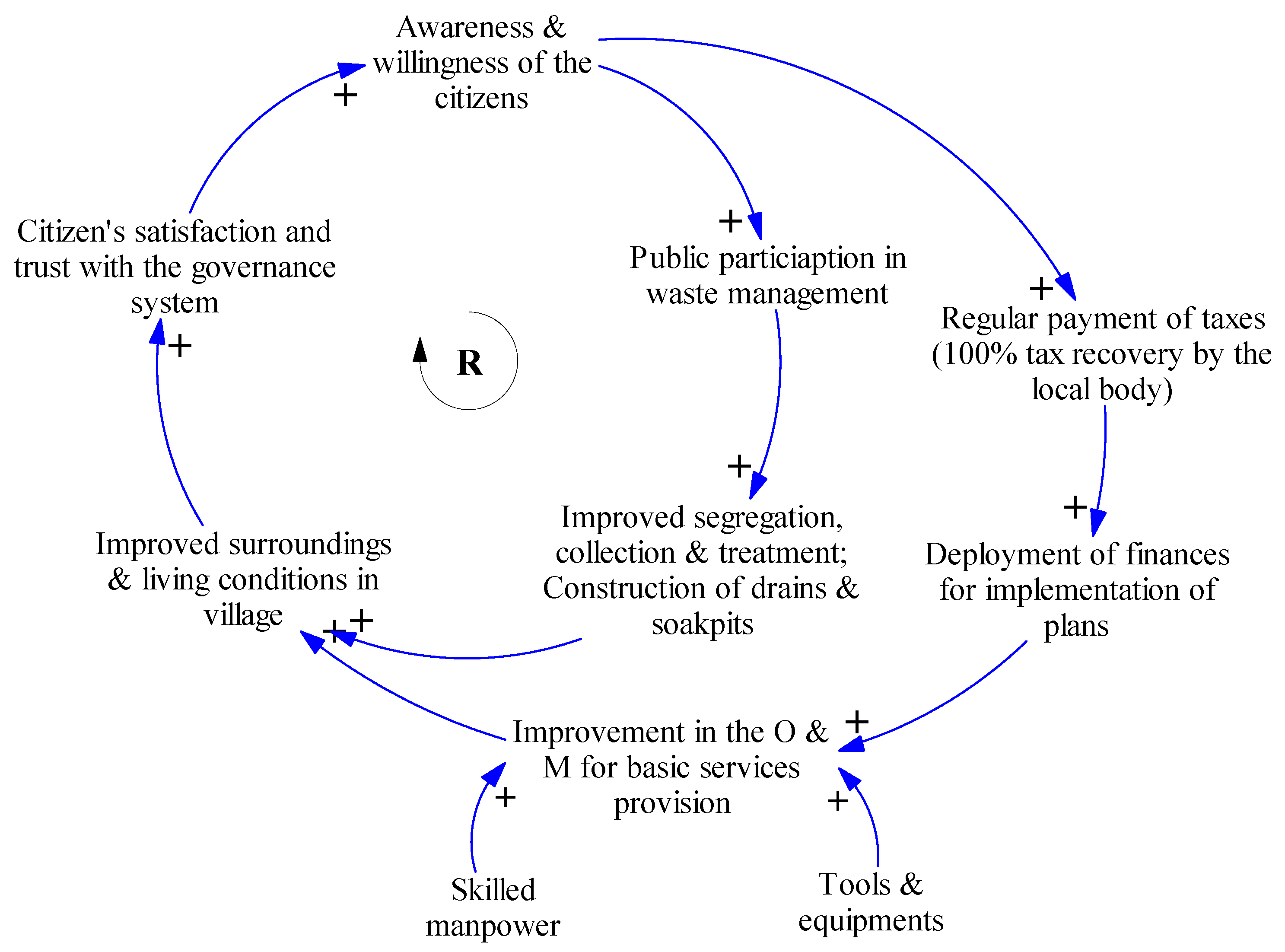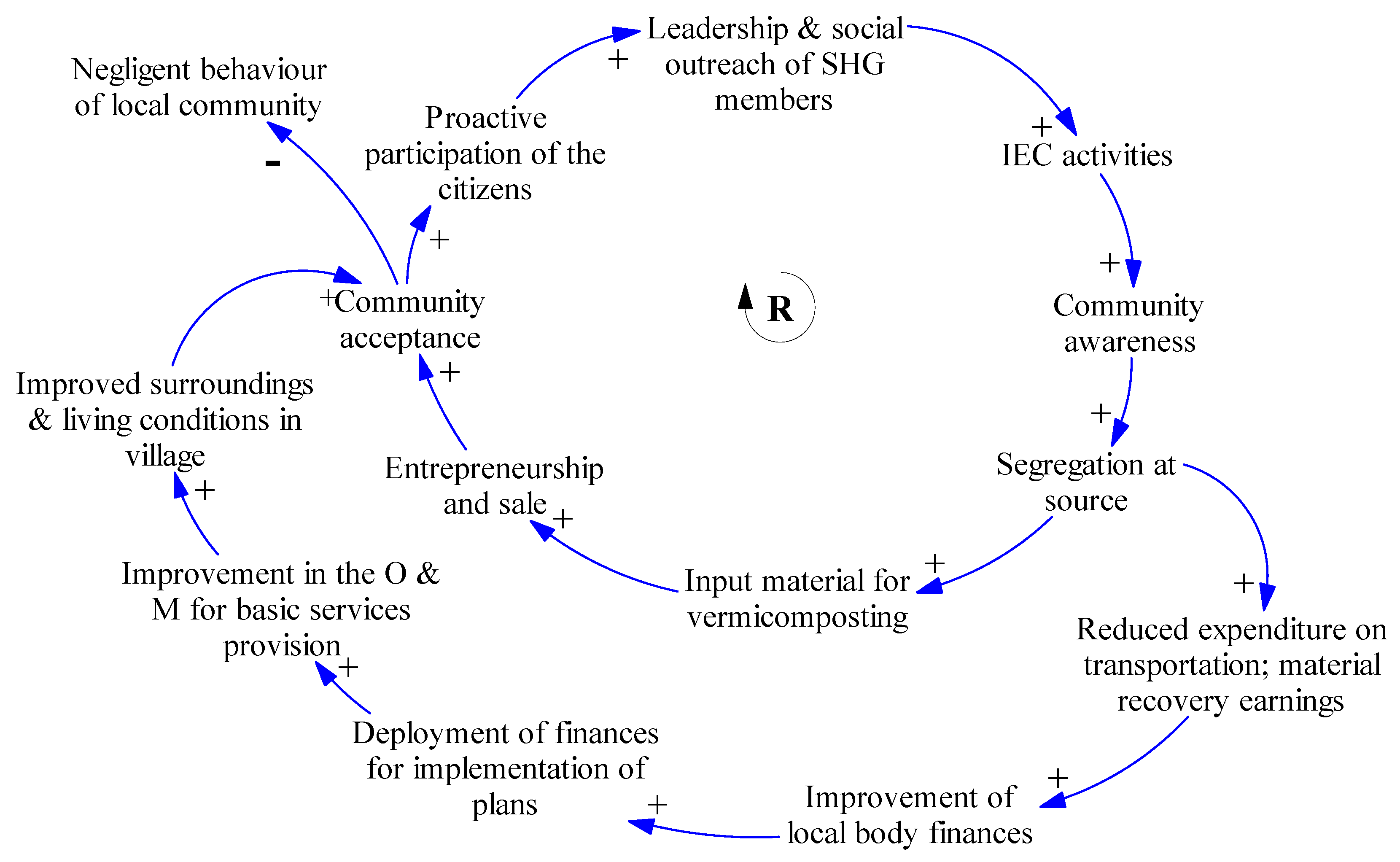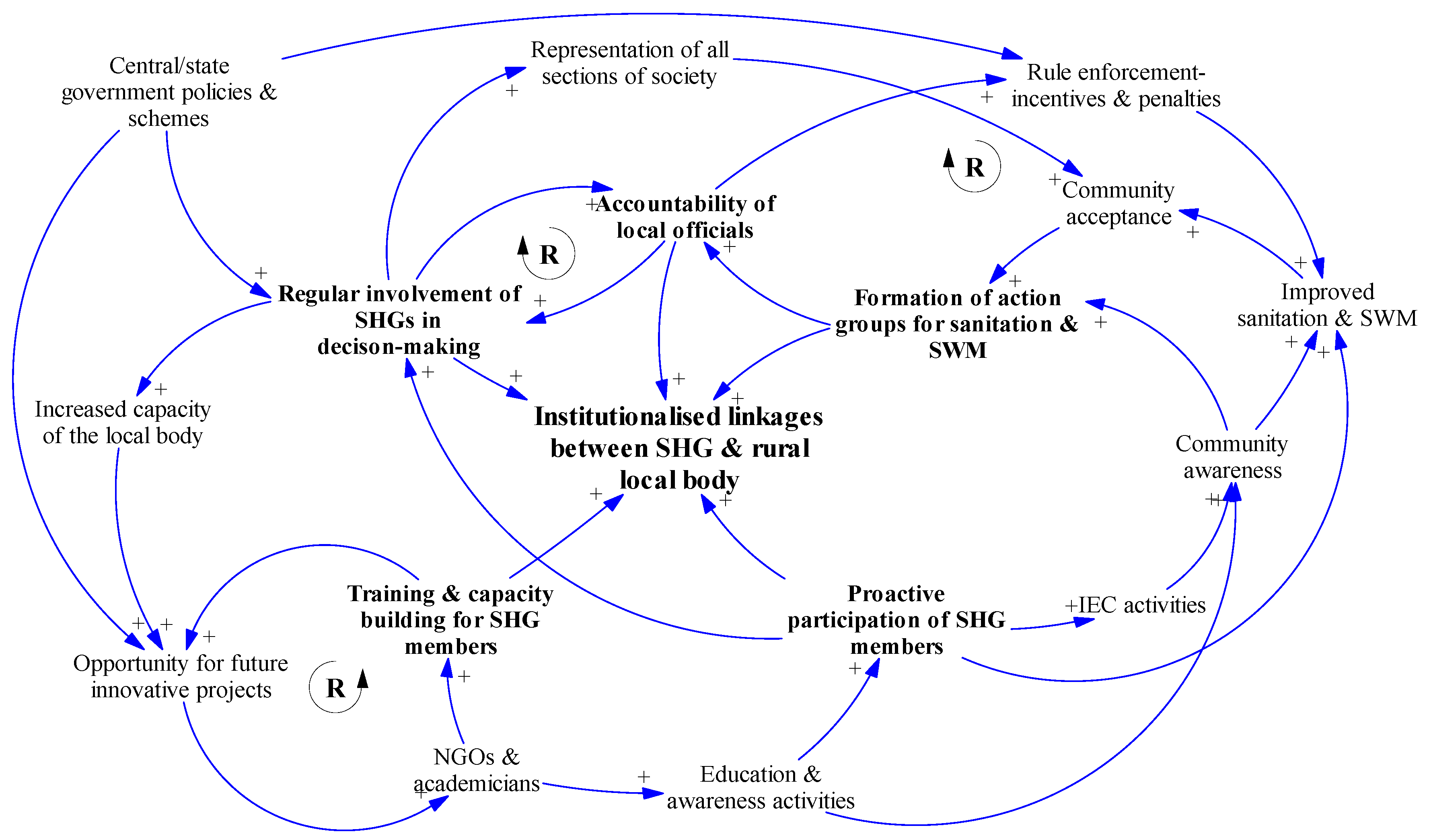1. Introduction
Urban areas throughout the world are rapidly expanding; the proportion of the urban population in the world is expected to increase from the current 55% to 68% by 2050 [
1]. Some of the fastest urbanizing regions in the world are in developing countries; 93% of urban population growth is expected to occur in these countries [
2]. A large part of this growth is occurring not in urban cores, but in peripheral areas [
3]. Metropolitan growth and the expansion of urban functions into the periphery is a worldwide phenomenon [
4] and comes with a downside. These areas are classified as rural, but they have a high population growth rate and a rapidly changing socio-economic context. Lack of management and planned growth occurs in peri-urban areas, resulting in a host of problems, from unrestrained land-use conversion and increasing population density to a lack of essential services, such as sanitation and waste management [
3]. In the case of India, there is a lack of studies regarding peri-urban villages that focus on the institutional structures and decentralization processes [
5,
6]. The diverse processes involved in rural-urban transformation, from a rural perspective, have received meagre consideration from policy-makers in the country [
7,
8]. The majority of the rural population in peri-urban villages is underprovided for in terms of basic health services, such as water and sanitation. During the recent past, these urbanizing villages have received some consideration in government schemes in terms of the provision of basic services. However, they have been largely neglected in actual policy and practice [
9].
Efficient sanitation and waste management mechanisms are based on the principles of equitable accessibility for all citizens, effectiveness of the system in maintaining cleanliness, efficiency in terms of costs and the optimal use of resources, and sustainability from all perspectives [
10]. The conventional planning strategy of a needs-based approach in providing infrastructure is rigid. It does not work well in a dynamic peri-urban setting of increasing needs and limited powers and resources of the rural administrative setup. Existing research suggests the need for evidence-based policymaking that depends on the participation of citizen themselves to prioritize and make decisions [
11,
12,
13]. This is because an ideal democratic setup is one where people have power over choices related to the aims and goals of any governmental action [
14]. A shift from prescriptive planning approaches to a context-specific planning process can ensure equity in the distribution of resources and services [
15,
16]. Community-led development approaches are being actively used in many parts of the world to involve local communities in designing and delivering plans for development [
17,
18]. Particularly, for the provision of basic health and sanitation services in peri-urban areas, public participation in policy formulation and implementation is being increasingly prescribed and is also being considered as a standard practice [
19,
20].
Work on improving relationships and social networks is a major part of asset-based community development [
12,
21,
22]. Literature exists that shows that in the case of complex problems with a weak institutional setup, governance in the form of collaborative social networks helps in overcoming operational challenges, and is beneficial in the implementation of new policies for social, economic, and environmental betterment [
23,
24]. Scholarship on the collective action theory by Ostrom [
25,
26] identifies reputation, trust, and reciprocity to be the basic variables affecting cooperation and the success in social outcomes of collective efforts. Based on this background, the research focused on the potential of self-help groups (SHGs), with their ground-level connection to the local community, as important community stakeholders to develop a participatory mechanism for sanitation and solid waste management (SWM) services in a peri-urban village. The study posits the analysis and inferences with a consideration of the fact that the efficient functioning of SHG networks is not just dependent on their capability to provide financial assistance, but also on the women’s participation and sharing of experiences [
27].
SHGs are voluntary groups of 10–20 individuals (mostly women), who save a nominal amount monthly. The saved amount is used to provide credit to members depending upon their needs. Sundaram [
28] and Saravanan [
29] discussed the economic impacts of SHGs on rural societies, but there is a lack of research regarding other forms of social impact by SHGs. The
Swachh Bharat (Swachh Bharat means ‘clean India’. The Swachh Bharat Mission was launched by the Government of India with the aim of improving cleanliness through solid and liquid waste management.) Mission of the Government of India suggests the possibility of involving such community-based organizations for positive implementation of sanitation and SWM schemes [
30]. It was initiated in 2014 with separate components for urban and rural areas. With regards to the rural component, the basic guidelines of the mission not only focus on sanitation and SWM coverage, but also on encouraging cost-effective and sustainable technologies, and developing community-managed systems. It prescribes the constitution of a Village Water and Sanitation Committee for conducting works related to sanitation and SWM programs at the
gram panchayat (Gram means village and Panchayat means an assembly or council. Gram panchayat is the term for the rural local body. Members of this assembly are directly elected by the villagers.) (GP) level. Until now, the provision of sanitation and solid waste management services was not a part of the obligatory duties of the GP under the decentralized functions by the Government of India. A general maintenance of sanitary conditions by removing rubbish heaps and preventing water logging was one of the assigned tasks for the GP. The earlier schemes of the ‘Total Sanitation Campaign’ in 1999, and ‘Nirmal Bharat Abhiyan’ in 2012 emphasized the construction of household toilets, and under these schemes, the sanitation coverage increased in rural areas. However, the results have not sustained for a longer period of time [
30]. The
Swachh Bharat Mission tries to address this by prescribing awareness creation and a social inclusion culture for the sustainability of the proposed implementations. It also cites behavioral change as being crucial for community-level hygiene, and suggests information, education, and communication activities for the same.
The Mumbai Metropolitan region (MMR) is the most populated urban agglomeration in India [
31] with Mumbai city as its core; various other urban nodes are present in the region. A significant urban growth has been occurring in rural areas around the municipal corporations (a municipal corporation is the highest form of urban local government for the administration of big cities.) without an adequate provision for necessary basic services and physical and social infrastructure [
32]. The Bhiwandi Surrounding Notified Area (BSNA) is a cluster of villages that has witnessed the development of secondary and tertiary sector activities because of their proximity to urban centers and their good connectivity with other parts of the state and country. A documentary review of the Draft Regional Plan 2016–36 shows that the plan does not focus on areas outside urban administration for the provision of basic services. Peri-urban villages are disadvantaged when it comes to development planning, due to their administrative status. The development plan for BSNA [
33] prepared by the regional development authority focuses on the issues pertaining to the neighboring Bhiwandi Nizampur City Municipal Corporation, and mentions BSNA mainly in terms of spill-over requirements. It provides only brief overall recommendations for the land area required for a solid waste landfill and sewage treatment. There is a lack of in-depth analysis regarding the existing local conditions and the possibilities for community engagement in these peri-urban villages. This study explores effective mechanisms to support the roles of SHGs in particular and the community in general, and contributes towards assessing the needs and delivering basic services in peri-urban areas. Awareness generation and information dissemination are important steps towards this and a methodology has been formulated for conducting a participatory workshop in Anjur village within the BSNA. Through this research, theoretical insight is gained regarding the drivers for developing an SHG-participation-based model of waste management service provision in peri-urban villages. The inferences are generalized to the whole community based on the premise that the initiation of a cooperative venture involving SHG women will increase the trust and motivation of the community to follow their lead in contributing to the system.
3. Results
In the pre-discussion questionnaire, 41.4% (
n = 24) of the total 58 participants responded that waste management in the village is the sole responsibility of the GP, whereas the remaining 58.6% (
n = 34) answered that it is the responsibility of both the GP and local citizens (
Figure 3). In the post-discussion questionnaire, these percentages positively changed, and 96.6% (
n = 56) of the respondents were of the opinion that it is the responsibility of both the GP and citizens.
As for their opinion on what constitutes the SWM process, answers were divided into three categories (
Figure 4). In the first questionnaire, 53.4% (Category A;
n = 31) of the participants answered that SWM consists of burning the garbage or dumping it away from the residential part of the village; 15.5% (Category B;
n = 9) were partly correct in answering that it consists of collection, transportation, and then disposal; and 31.0% (Category C;
n = 18) correctly answered that the different stages are segregation, treatment, collection, transportation, scientific disposal as well as reduce, reuse, and recycle. In the second questionnaire session, the percentages of respondents for categories A, B, and C are 0.0% (
n = 0), 15.5% (
n = 9), and 84.5% (
n = 49), respectively.
Out of the 21 SHGs whose members participated in the workshop, members from seven SHGs reported that they undertake work apart from providing loans. The work included gathering volunteers for tree planting and cleanliness drives, supplying cooked food to the health center, growing and selling vegetables, and sourcing agricultural equipment for those requiring it in the village.
For the question regarding the waste water disposal method being adopted by the household, only a meagre 12% reported constructing a soak-pit for the waste water from the kitchen and bathroom. During later discussions with officials, it was shown that the proportion of houses with soak-pits is very low, approximately 5%–10%, for the entire village.
Many locations in the village have garbage heaps (
Figure 5a). The open drains or channels from the houses are also in an ill-maintained condition (
Figure 5b). In the pre- and post-discussion questionnaires, the participants showed their awareness regarding the ill effects of improper solid and liquid waste management in the villages. They identified the prominent ill effects of improper waste disposal, such as garbage heaps, resulting in bad odors, mosquitoes, and diseases. Based on official records, Anjur village has a total of 24 seats (12 each for males and females) in community toilets. However, only 12 were found to be in a usable condition, based on the post-workshop visit to critical locations with some of the participants and local body officials. In the questionnaires as well, only 51.7% of the participants positively responded to the question regarding the maintenance and usability of community toilets.
Post workshop, 100% of the participants positively responded that the SHG women can contribute towards cultivating awareness and changing the attitudes of the local community. A total of 95% of the participants also positively answered to working with the local body to improve service delivery and devoting 3 to 4 hours per week for this task. The two participants with a negative response to this question cited the reason that household work consumes all their time. However, they were willing to take the necessary steps at the household level.
Because the analysis of the workshop results was aimed towards understanding the development of linkages between the SHGs and GPs, the participants’ opinion regarding what they expect in return for working towards waste management in the village was obtained. Most of the participants provided multiple responses and the frequencies of the different answers are detailed in
Table 1.
The possibility of initializing a vermicomposting setup was discussed, with positive inputs from officials and also the SHG women. Two of the participants voluntarily summarized the means by which the SHGs could support the local body. The concluding remarks focused on the measures required for the creation of an enabling environment for the SHGs. These are elaborated upon in the discussion section of this article.
4. Discussion
The reflective discussions conducted during the workshop are critical in identifying the key factors for establishing a partnership model for the provision of waste management services in the village. Peri-urban villages present a special scenario for planning and management. Because they are on the urbanization track and are witnessing changes in the socio-economic structure, local citizens are exposed to a wide range of possibilities and ideas. Simultaneously, there is also an element of social cohesion that is inherent in villages that is generally lacking in urban centers. Institutionalizing linkages between the SHGs and the rural local bodies can help in developing flexible and feasible networks at the local level, which in turn can help in overcoming the governance deficiencies in peri-urban areas.
An archetype observed in the village was deduced from the discussions of the earlier field visit. As shown in
Figure 6, it is a balancing loop (indicated by the letter ‘B’ and curved arrow in the center) illustrating that a negative attitude of the community prevents active participation, which further worsens the waste and sanitation situation. Based on the workshop results, a substantial positive change was observed in the responses of participants in the pre- and post-discussion questionnaires regarding the awareness of SWM and sanitation concepts. In-depth discussions regarding the processes involved in managing solid and liquid waste, and how the SHG women can contribute towards each step, helped in improving the understanding of the participants. The discussions among the participants before they provided their final views, and the visit to problematic areas in the village, were an opportunity for them to understand each other’s perceptions. It also aided in identifying the waste dumping locations and the areas with a significant requirement of drainage provision.
In peri-urban villages, where citizens prioritize working for the basic necessities of life, the implementation of a sanitation and waste management program will be of secondary or lower priority. Hence, the Ministry of Drinking Water and Sanitation [
40] specifies convenience, understanding, and approval as the key aspects influencing individuals or a community to change their behavior and adopt new or improved practices. Based on these concepts, the deliberations focused on motivating the participants to understand the risks of unmanaged waste and the importance of eliciting a change in the situation. With input from the VDO and local leaders, the possibility of a social enterprise for vermicomposting was also explored. Production of vermicompost and generation of income by its sale could have a positive socio-economic and environmental impact on the living conditions in the village. Such a social enterprise by the SHG women will contribute towards solving waste management problems and help in addressing other community challenges, as it will be fundamentally more inclusive. The community-led initiative will follow a more rights-based approach [
3] as the SHGs are not exclusive to any section of community and include groups of different income levels and caste-based divisions in society. SHG involvement in service provision and management will ensure representation of all segments of society.
Interactions between different stakeholders for the construction of alternative visions and new possible scenarios were mapped with the help of CLDs to qualitatively discuss the influences of different factors in the system. The CLDs were formulated in an iterative manner through multiple meetings with local leaders to incorporate the issues raised during the workshop. The first feedback structure as shown in
Figure 7 presents the overall benefits of public participation in sanitation and waste management. It is a reinforcing cycle (indicated by the letter ‘R’ and curved arrow in the center) asserting the direct influence of an active and well-informed community on living conditions in the village, which will in turn positively influence the satisfaction levels of the community.
The CLD shown in
Figure 8 is a predictive representation based on the comments of participants and local leaders. It shows a positive feedback loop created by the leadership skills and social outreach of SHG members on the SWM mechanism for the village. This includes the aspects of a vermicomposting venture led by the SHG women, and improvement of the financial base of the local body. This in turn stimulates societal approval for participation and encourages further participation of SHG members as well as other citizens.
An important point that was noted in the discussions was that the SHGs and the local body could hold meetings for the formation of specific action groups, including, in particular, skilled people, representative individuals facing specific issues, SHG leaders, youth organization representatives, and any other locals who are interested in becoming a part of community activities. The action groups can conduct specific activities, such as raising awareness, supporting soak pit construction, supporting waste segregation and collection, conducting the vermicomposting process, and collaborating with support organizations for marketing the produced compost. The groups can be useful even during the post-implementation stage, for obtaining feedback from the community for further improvements to the mechanism. This could be among the means to elicit the necessary change of making the process people-centric instead of producer-centric, as proven to be necessary for a successful service provision mechanism [
11]. The entire process would be more sustainable if all the citizens are involved, and hence, the partnership between the SHGs and rural local body can be used as an entry point for the involvement of other members of their respective households and other citizens in general.
The combined diagram with the desired outcome as ‘Institutionalized linkages between the SHGs and local body’ is shown in
Figure 9. The actions suggested by the workshop participants and leaders, to achieve institutionalization of SHG-local body linkages, are the five nodes directly connected to the desired outcome. Important drivers for the success of the system are used to create a broader picture and improve the understanding of the connections between them.
The State Women’s Development Corporation through the Government Department of Social Welfare, and the Department of Women and Child Development, conducts training programs for women (personal communication, September 26, 2018). With the aid of non-governmental organizations (NGOs) and other academic organizations, training and awareness for SWM and sanitation activities can also be conducted for the SHG women. This can act as a leverage point to intervene in the system, as also shown in
Figure 9. Central and state government policies can also influence SHG involvement by framing various guidelines for institutionalizing their participation in the service provision and through long-term incentives. Such a collaborative form of governance with the SHG involvement is an opportunity for service co-production. Co-production implies ‘the contribution of service users to the provision of a service’ [
41] and is a continuous research topic [
42]. As quoted by one of the participants:
“Collaborative working will allow us to supplement the inadequate service provision by the gram panchayat. If all the SHG women come together, then Anjur village will be just like a well-managed city.”
The CLD indicates that the accountability of local officials is an important factor, the absence of which can cause a failure in other aspects, leading to institutionalizing linkages. Thus, an effective model for the provision of basic services will involve an acknowledgment of mutual dependence on the part of all stakeholders to succeed. Notably, although governance and co-production are two different terms, they should not be considered unrelated when it comes to designing an intervention model for the provision of basic services.
To apply the understanding generated by the CLDs to better service delivery through a coordinated approach, it is aligned with the principles of sociocracy. Sociocracy is a model of self-organization independent of scale [
43] that can be used to develop a collaborative system that can function as an organic whole [
44]. Bockelbrink and Priest [
45] have developed an easily implementable form, termed Sociocracy 3.0, which can be used for applications at the community level. We listed the seven principles of Sociocracy 3.0 and interpreted how they can be related to SHG involvement in basic services’ provision in the village (
Table 2). The points in the table give clear procedures for approaching an integrated form of working of the SHGs and the local body. A participatory approach complemented by these principles will help to organize the planning process, and have a high adaptability in other areas as well.
Based on the aforementioned description, we can conclude that institutionalizing the relationship between the SHGs and the local body is positively related to the robustness of the socio-environmental conditions in the peri-urban villages and SHG participation will also encourage improvement in other aspects of governance. The regulatory and adaptive capacities of the local body will increase in such a model. It is important to mention that Huitema et al. [
46] point out the probability of higher transaction costs of community engagement due to a need for coordination between different stakeholders. Ostrom [
26] also speculates increased conflicts due to heterogeneity within participant groups. However, SHGs have the potential to offer an opportunity for collective action because they are set up, and promoted, on the very concept of equivalence; a level of trust and teamwork already exists between the members for the effective functioning of the group. Continuous interactions between the members increase the sense of cooperation.
There are certain limitations to the methodology followed in this research. The participants in the workshop were local women who were members of an SHG; non-members were not included. This was mainly because the research specifically focused on linkages between the rural local body and the SHGs. Another reason was to limit the number of participants to ensure committed and dynamic involvement [
36]. There is a scope of social desirability bias (social desirability bias is the tendency of respondents to report an answer inaccurately to project themselves in a socially acceptable manner.) affecting the responses of the participants in such a workshop, particularly in the post-discussion questionnaire. Hence, informal discussions with the participants were done after the program ended to confirm the views expressed by them during the workshop. An additional concern would be that the causal links in a complex CLD can be exhaustive. For example, the government schemes at the national and state level can be influenced by political factors, or that the level of awareness can be dependent on pre-existing gender norms in society. The final diagrams, however, show the links that were deemed to be the most important by the participants and local leaders.
5. Conclusions
At the core of its idea, public participation is about creating links between citizens and decision-makers. It ensures that policy-makers and planners consider the viewpoints of the local community while performing their tasks. Sustainable Development Goal (SDG) 11 also advocates a place-based approach to development through partnerships between different groups of stakeholders. In the case of rapidly developing regions, it is essential to engage in planning and policy making with a social perspective for long-term benefits. The villages within the boundaries of the metropolitan regions are at a further disadvantage because of the focus on ‘urban’ areas in the planning process of regional authorities. This research formulated a methodology of conducting a workshop, followed by the development of CLDs, to develop a set of interactions necessary for improving the planning and provision of basic services through the combined efforts of the rural local body and the SHG members in Anjur village within the MMR. The combined participation of citizens and local officials, and mutual discussions between them, were steps towards building healthy relationships for the future. Such a methodology aids in maintaining the flow of information in both directions, from the governing body to the community, and vice versa. It helps to view policy making from a grassroots perspective. Discussions such as these can help enable SHGs to voice their opinion as well as increase their problem-solving capacities. Discussions are also better than problem-oriented data collection questionnaires because they orient the analysis towards a capacity-focused form of development. Face-to-face communication, as a variable, has been postulated to have a relation with increased trust, and higher prospects of the participants to achieve positive outcomes through collective action [
26,
47]. The results lead to the development of proposals based on the strengths and acceptance of the SHG members. The workshop helped raise awareness in the SHG members and thus contributed towards recognizing and developing their capabilities. Involving SHG members directly in planning and implementation processes will lead to better choices by residents of peri-urban villages regarding implementations that they would prefer. This results in a balance in power between the rural local body and the citizens.
Eliciting a change in the community perspective is not a one-time thing and requires persistent efforts [
36]. Future work in this regard could include conducting such workshops at regular time intervals and also in other villages. To reap continued benefits from such community-specific awareness programs, collaborations can be initiated between the administrative stakeholders, SHGs, NGOs, and academic institutions. Such collaborations can help in developing and successfully undertaking community-centered awareness programs. SHG members can also be trained to disseminate information through door-to-door visits, sessions in the village primary school, or during community celebrations. The methodology in this research of using CLDs to interpret the workshop results and aligning those with other aspects of governance presents a range of interlinked factors. It offers adaptability to be applicable in varying contexts of peri-urban villages. The type and extent of SHG engagement can be developed in consultation with all the stakeholders. For this model to be duplicated in more urbanized villages, there is a probability of a challenge being faced in terms of less social cohesion. In such cases, the policies and rule enforcement of the state can be an important determinant by providing the necessary guidelines to institutionalize such a cooperative functioning.
Regarding basic services, such as sanitation and SWM, less capital-intensive solutions are bound to be more acceptable, along with higher community involvement. Economies of scale can be used in solving the issues of peri-urban villages. The Maharashtra state government has taken a step in the right direction by declaring all the villages in the region as a notified area (an undeveloped area may be specified as a ‘notified area’ by the state government after issuing a notification in the official gazette. The state government may also constitute or appoint a body to be the Special Planning Authority for the notified area (Maharashtra Regional Town Planning Act, 1966–Section 40)). However, steps must be taken to plan for these villages from their perspective, and not just focus on neighboring urban local bodies, as highlighted in
Section 2.1 from the development plan of BSNA [
33]. Molen [
48] defines governance capacity as encompassing three aspects—regulatory, adaptive, and integrative—and infers the need for interactive and flexible arrangements for governance. The findings from this research add to this by formulating CLDs that depict relationships between the local body, SHGs, and NGOs, and suggesting the requirements for a sustainable model of SHG participation in the provision of sanitation and waste management services in the village. The authors also build upon the conclusions of Kandpal and Saizen [
6] regarding the deficiencies in the institutional framework of the MMR. Through this research, it can be concluded that multi-level relationships can work better when the focus of higher-level authorities is on the level of provision of service and community satisfaction, instead of being mainly on building infrastructure. However, for any effort to be successful, the accountability of government officials is a pre-requisite and cannot be completely substituted. The establishment of formal connections between the rural local body and SHGs will impact the willingness and capacity of the members of both. This in turn will lead to sustainability in the positive outcomes of this relationship.
